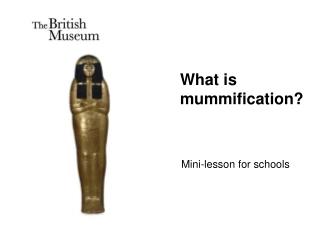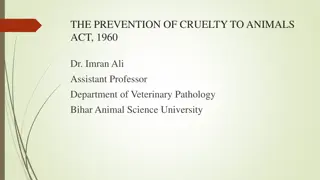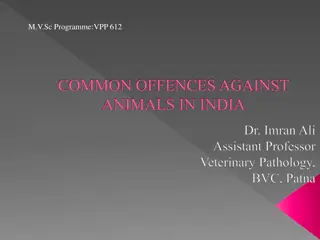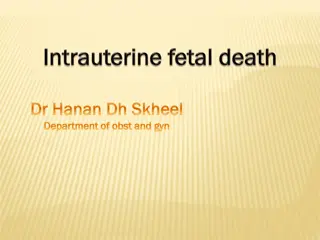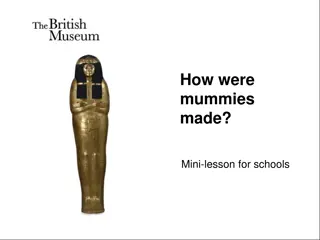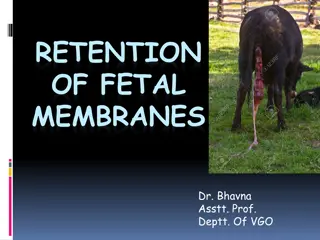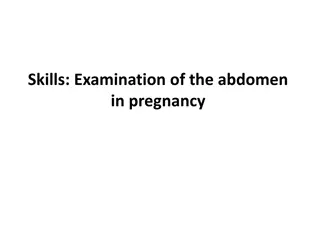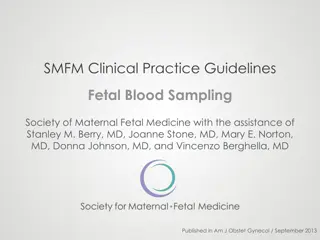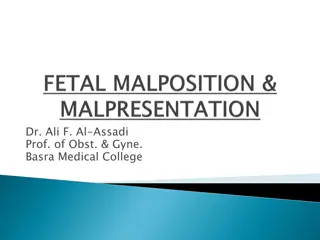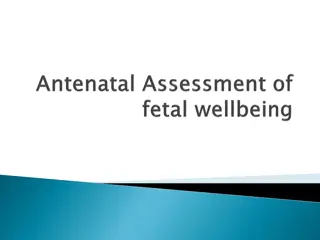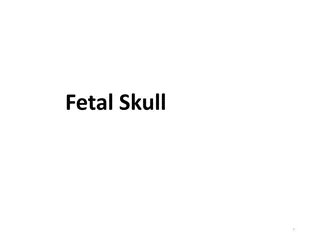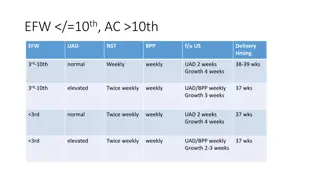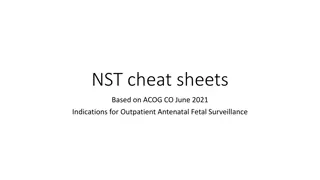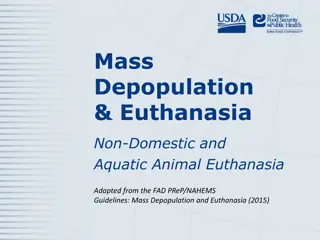Fetal Mummification in Domestic Animals
Failure in pregnancy stages can lead to fetal mummification, characterized by autolytic changes, mummification process, and dry, leathery tissue. Events required for mummification include fetal death post-bone development, rapid resorption of fluids, absence of oxygen and bacteria. This process is commonly seen in various domestic species such as cattle, sheep, goats, horses, swine, dogs, and cats, with a higher prevalence in swine. Two types of mummification observed are hematic or chocolate mummification in cattle and papyraceous mummification in other species leading to the formation of a dry, stiff fetoplacental unit without any exudate.
Download Presentation

Please find below an Image/Link to download the presentation.
The content on the website is provided AS IS for your information and personal use only. It may not be sold, licensed, or shared on other websites without obtaining consent from the author.If you encounter any issues during the download, it is possible that the publisher has removed the file from their server.
You are allowed to download the files provided on this website for personal or commercial use, subject to the condition that they are used lawfully. All files are the property of their respective owners.
The content on the website is provided AS IS for your information and personal use only. It may not be sold, licensed, or shared on other websites without obtaining consent from the author.
E N D
Presentation Transcript
Fetal Mummification Dr. Bhavna Assistant Professor Deptt. of Veterinary Gynaecology and Obstetrics
Introduction Failure of pregnancy is usually divided into stages based on the fetus s development and potential viability:embryonic mortality and fetal mortality. The exact outcome of early fetal mortality is unpredictable and influenced by several factors: 1. cause of the fetal mortality 2. species differences 3. stage of gestation at fetal death 4. number of fetuses
Fetal death in domestic animals occuring during the middle gestation that does involution of the corpus luteum and is followed by: autolytic changes in the fetus, absorption of placental and fetal fluids, involution of the maternal placenta,and mummification of the fetus. or last not third result of in
Autolysis involves two steps: 1) the release of digestive enzymes normally present in organs like the intestine and liver,and 2) the breakdown of organic matter by bacteria,or putrefaction.
Mummification stops autolysis/ decomposition. Dry conditions (tissue water decreases) low oxygen conc. Inhibits bacterial putrefaction Tissue becomes dessicated Body shrivels to a dry, leathery mass of skin, tendons and bones
Events that must be present for fetal mummification 1. The fetus must die after the development of bones is complete. 2. Uterine and fetal fluids must be resorbed relatively rapidly. 3. There must be no oxygen in the uterus until the mummification process is complete. 4. There must be no bacteria in the uterus.
Occasionally diagnosed in many domestic species, including the cow, sheep, goat, horse, swine, dog, and cat, with the highest prevalence occurring in the swine. Swine Small ruminants (Goats and Sheep) Cattle Cats and Dogs Horses
Two types: 1. The hematic or chocolate mummification (in cattle) 2. The papyraceous (in other species) Produces a dry, stiff fetoplacental unit with no exudate.
Hematic Mummification Involution of maternal caruncles Haemorrhage between endometrium and fetal membranes Plasma gets absorbed Reddish-brown gummy, tenacious mass of autolysed red cells, clots and mucus Imparts reddish-brown colour to the fetus and fetal membranes
Cattle Approx.0.13-1.8% incidence. High incidence in Guernsey and Jersey breeds. Higher risk of recurrence (30%) in cows that have experienced previously. Occurs after 70 days of gestation. Most often between 3rdand 8thmonth of pregnancy. The longer the fetus is retained, the dryer, firmer and more leathery it becomes.
Causes Bovine viral diarrhea (BVD) Leptospirosis Mould (Neospora caninum) Compression/torsion of umbilical cord Uterine torsion Defective placentation Genetic anomalies Abnormal hormonal profile Chromosomal abnormalities
Clinical findings and Diagnosis Cow s abdomen to be unusually small for the given stage of pregnancy. Body changes incident to parturition and calving fail to occur. Transrectal palpation compact, firm and immobile mass without placentomes and no fremitus. placental fluid or USG absence of heartbeat and fetal fluids.
Treatment Prostaglandins (PGF2 ) are the primary and most effective treatment tromethamine or 500 g,Cloprostenol Sodium). Estradiol benzoate @ 20mg i/m Epidosin @ 20mg/100kg body weight i/m (10 ml) Uterine lavage Hysterotomy,if fetus fails to be expelled. Prognosis Both medical and surgical approaches result in normal pregnancy rates. (25 mg, dinoprost
Goats and Sheep Uncommon but may affect one or both fetuses. Associated with 4 major infections: 1. Toxoplasma gondii 2. Chlamydiphtla abortus 3. Border / hairy shaker disease 4. Coxtella burnett (PoxChBCox)
Energy and protein deficiencies, particularly on days 90 120 of gestation. Mummified fetuses are spontaneously aborted.
Horses Very rare, associated with the death of a twin fetus. The majority of surviving twin pregnancies abort at 9 11 months of gestation. Ultrasonography-guided twin reduction via a transvaginal (vesicular injection) or transabdominal injection) approach may result in mummification of the dead fetus. aspiration or fetal (fetal cardiac
Clinical findings fetuses are Mummified during a normal pregnancy,dystocia during foaling or prolonged pregnancy. found unexpectedly Diagnosis Uncomplicated Transrectal palpation and ultrasonography show a hard and bony structure without fluid in the uterine lumen.
Treatment Where elevated progesterone is associated with a CL, PGF2 (25 mg dinoprost tromethamine IM) is indicated. In the absence of a CL, 17 -estradiol (5 mg IM) or PGE1 (200 g Misoprostol) administered locally on or in the cervix 24 hours before oxytocin is administered. Caesarean section,if large in size. Uterine lavage to remove debris is indicated.
Prevention Close ovulation and so enable the diagnosis of double ovulation and confirm a twin pregnancy early (on day 14) is recommended. monitoring to determine time of Allows for early twin reduction in order to optimize success, and minimizes the risk of fetal mummification, reduces the risk of twins, and optimizes the future fertility of the mare.
Swine Overall prevalence is 1.5%. Possible after 35-40 days of pregnancy. Has been linked to 1. Parity 2. Litter size 3. Uterine capacity 4. Environmental temperature 5. Presence of mycotoxins 6. Infectious diseases
Presence of one mummy in an otherwise normal litter may indicate physiological death, whereas the presence of multiple mummified fetuses indicates an infectious cause.
Infectious mummification in swine : 1. Porcine parvovirus (PPV) 2. Aujeszky s disease / pseudorabies virus (AD/PRV) 3. Encephalomyocarditis virus (EMCV) 4. Erysipelas (bacteria) 5. Japanese encephalitis virus (JEV) 6. Porcine circovirus 2 (PCV2) 7. Porcine reproductive and respiratory syndrome virus (PRRSV) 8. Swine fever virus (SFV;African and classical) 9. Swine influenza virus (SIV) 10. Teschovirus agents potentially associated with fetal
Clinical findings Infection during early gestation ( 40 days) causes absorption of the infected fetuses, and the dam returns to estrus in a regular (18 24 days after heat) or irregular (25 38 days after heat) manner or fails to farrow. Infection between 40 and 70 days of pregnancy, causes infection to fetuses, resulting in the mummification of fetuses of different sizes at birth,alongside the healthy piglets.
Diagnosis The number of mummified fetuses relative to litter size and age at which death occurs is an indication of the potential etiologic agent. Insufficient space or a large litter - mummified fetuses associated with a normal litter size. Infectious agent - the litter size will be normal, but more mummified fetuses and less live piglets will be observed.
Prevention Proper care/comfort Optimal nutrition Effective stress management Rigorous sanitary protocols Vaccination
Dogs Most common cause is canine herpesvirus (CHV). Difficult to diagnose esp. if bitch consumes or hides the fetus. Proper vaccination may prevent.
Cats Mostly infection. due to Feline panleukopenia virus Accidently found during abdominal surgery and appear encapsulated wrapped in omental adhesions, or free in the peritoneal cavity beyond the normal time of parturition following normal birth or dystocia. within uterine tissue,


